An important note from CFTA: We are advocating for state issued guidelines so the arts sector in CA can reopen safely; we are not advocating to reopen arts until it is safe to do so and in accordance with public health. However, we are advocating for state issued guidelines so the arts sector can prepare to open and have parity with other sectors such as restaurants, shopping malls, cultural ceremonies, fitness centers and so on. We also want to be seen as part of the solution to the public health crisis offering an outlet for safe events and the mental health benefits of the arts. In addition, artists and culturally specific messaging will be integral to communicating the new behaviors we must adopt to get through this crisis. Wear a mask, stay safe and stay home as much as possible. We are all in this together.
Please submit questions and comments to our Google Form.
ACTIONS by CFTA/CAA:
California Legislative Members Urge Governor Newsom to Give the Arts Reopening Guidelines
CFTA/CAA presents testimony to the Arts, Entertainment, Sports, Tourism and Internet Media Committee
Keasha Dumas Heath's Powerful Testimony at Assembly Committee on Arts & Entertainment Hearing
California Art Advocates Write to Governor Newsom for State-Issued Reopening Guidelines
The Creative Industry Can Power California’s Economic Recovery
The Creative Industry Can Power California's Economic Recovery
Talking points for Federal & State Policy needs for the Creative Industries
California Art Advocates Write to Governor Newsom for State-Issued Reopening Guidelines
Julie Baker Urges the Assembly Committee to Host a Public Testimony Informational Hearing
Latest State-Issued Guidance
Effective April 1, 2022, requirements for vaccine verification or proof of negative test for Indoor Mega Events will be lifted and move to a strong recommendation.
Read CA Department of Public Health’s, Safe and SMART Events Playbook published April 1, 2022.
For more information visit CA Department of Public Health at: Beyond the Blueprint.
The Occupational Safety and Health Standards Board adopted revisions to the COVID-19 Prevention Emergency Temporary Standards to include the latest recommendations from the California Department of Public Health. The revisions will take effect on January 14, 2022. Read more.
CA Department of Public Health releases New Mega Events Guidance as of January 15, 2022
Lowers threshold for Indoor Mega Event to 500 attendees and Outdoor Mega Event to 5,000 attendees. For more information visit here.
For Indoor Mega Events (example: conventions/conferences/expos/sporting events and concerts):
In addition to the general public health recommendations:
• Verification of fully vaccinated status* or pre-entry negative test** result is required of all attendees.
• Indoor venue and event operators may not use self-attestation as a mode of verification.
• All businesses and venue operators must check the identification of all attendees age 18 and over to validate their vaccination record or proof of negative test.
• Acceptable identification is any document that includes the name of the person and photograph.
• Attendees must follow CDPH Guidance for Face Coverings.
• Information will be prominently placed on all communications, including the reservation and ticketing systems, to ensure guests are aware of testing and vaccination requirements (including acceptable modes of verification).
• Venues should make masks available to attendees upon request.
Face Coverings Q & A update as of December 15, 2021.
Persons who are actively performing at indoor live or recorded settings or events such as music, acting, or singing. If performers do not wear a mask indoors while performing, CDPH strongly recommends that individuals undergo screening testing at least once weekly. An FDA-approved antigen test, PCR test, or pooled PCR test is acceptable for evaluation of an individual's COVID-19 status.
Read California Department of Public Health’s Memo titled Beyond the Blueprint for a Safer Economy
When California fully reopens the economy, the state will move beyond the Blueprint for a Safer Economy. Beginning June 15, all sectors listed in the current Blueprint Activities and Business Tiers Chart may return to usual operations (with the limited exceptions noted below for Mega Events) based on the following general public health recommendations described on the CDPH website.
“We will only progress to this stage if we continue to stay vigilant, keep wearing our masks and getting vaccinated. The state will monitor hospitalization rates, vaccine access, and vaccine efficacy against variants with the option to revisit the June 15 date if needed.”
Older Resources:
State releases guidance for the Use of Face Coverings. Effective December 15, 2021, through January 15, 2022.
The purpose of this guidance is to provide information about when face coverings are required for members of the general public. It does not substitute for existing guidance about physical distancing and hand hygiene.
State Releases Guidance for Indoor Seated Events and Performances (Effective April 15, 2021)
The guidance for indoor and outdoor live events and performances does not apply to convention-style events, general admission venues, and events where the central activity allows patrons to move around shared space.
State Releases Interim guidance for Ventilation, Filtration, and Air Quality in Indoor Environments
This guidance is intended to be used for buildings for which the state or local health department is permitting business, assembly, or other occupancy or use to occur indoors.
State Updates Blueprint to Allow Additional Activities with Modifications to Reduce Risk (Effective April 15, 2021)
The Division of Communicable Disease Control (DCDC) works to promptly identify, prevent and control infectious diseases that pose a threat to public health, including emerging and re-emerging infectious diseases, vaccine-preventable agents, bacterial toxins, bioterrorism, and pandemics.
Updates to gatherings, receptions, conferences, and indoor live events and performances are effective April 15. Please note that California’s framework for loosening and tightening restrictions is governed by the level of COVID-19 spread.
Live Events Guidance (Effective April 1, 2021)
The Department of Alcoholic Beverage Control received approval to begin issuing daily licenses and catering permits for events covered under the ‘COVID-19 Guidance: Outdoor Seated Live Events and Performances” commencing on April 1, 2021. For more information visit the California Department of Alcoholic Beverage Control website.
Beginning April 1, 2021, follow this guidance for outdoor live events, entertainment, and performances PDF with seated audiences. Review the guidance and prepare a plan to support a safe, clean environment for workers, performers, volunteers, and patrons.
Social Images for Download
Let’s reopen arts safely again in CA whether on a rooftop, in a drive-in, streaming into your home or when we can at a lower capacities indoors, we need the arts.
We also need statewide guidelines for reopening arts safely. We continue to work with public health and the administration to issue guidelines for controlled live events consistent with the blueprint for a safer economy. Arts professionals have been sidelined as we put on gatherings for a living. Let us do our job to produce events safely for the community healing to begin. Controlled live events produced by professionals is far safer than gatherings at home. We can do this. #RestartArtsCA #artsareessential #artshealCA #ReopenArtsCA #artsadvocacy #artistsR2ndResponders



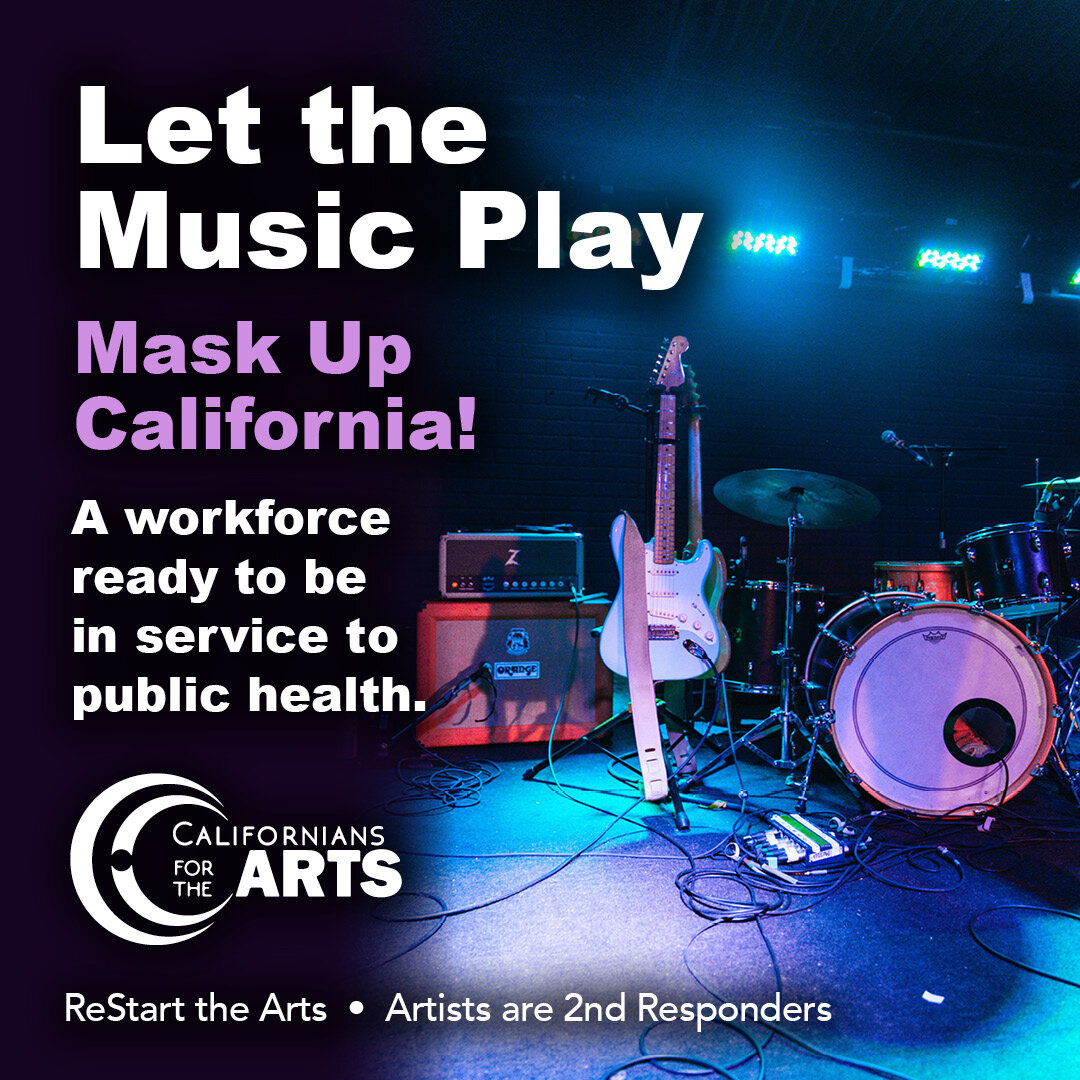
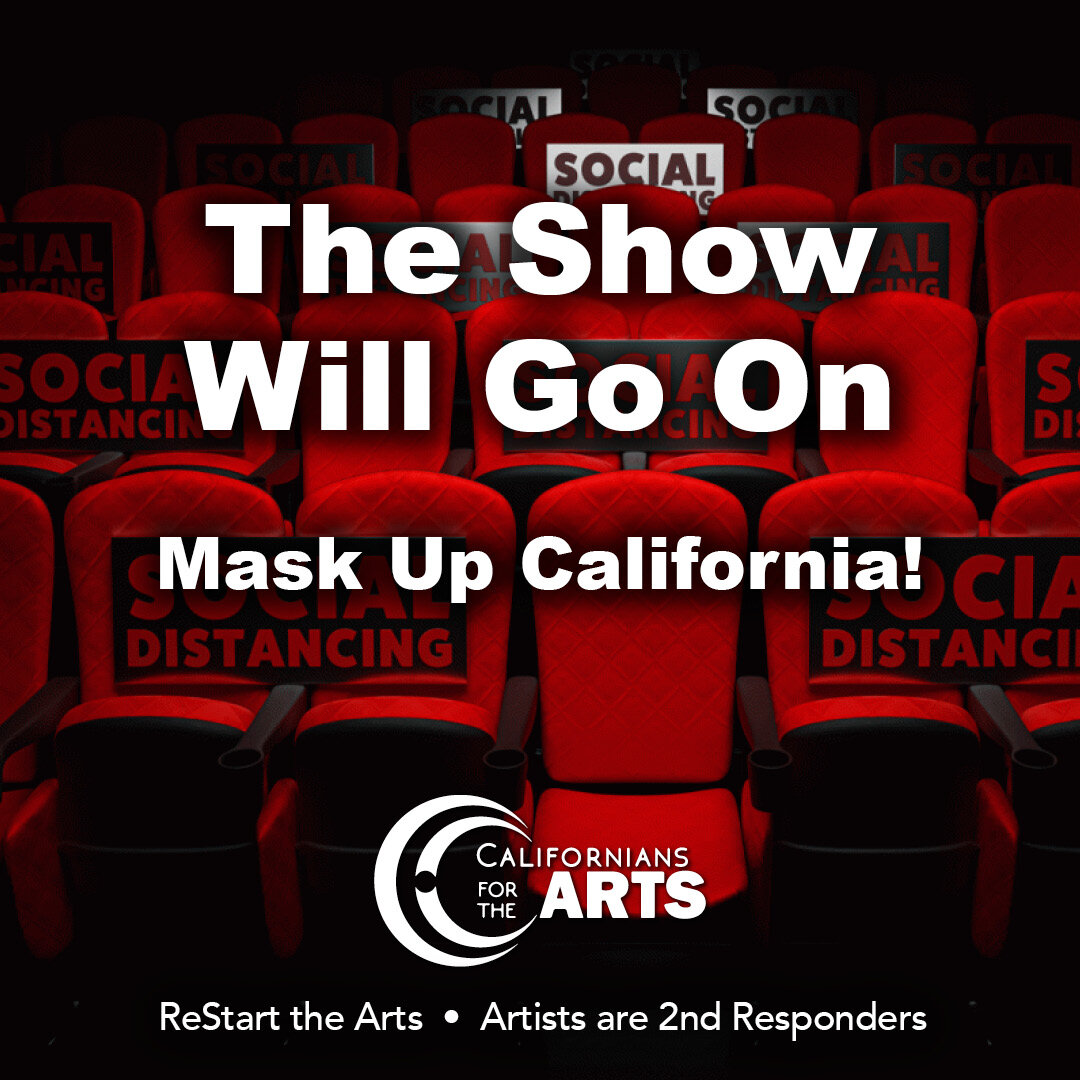




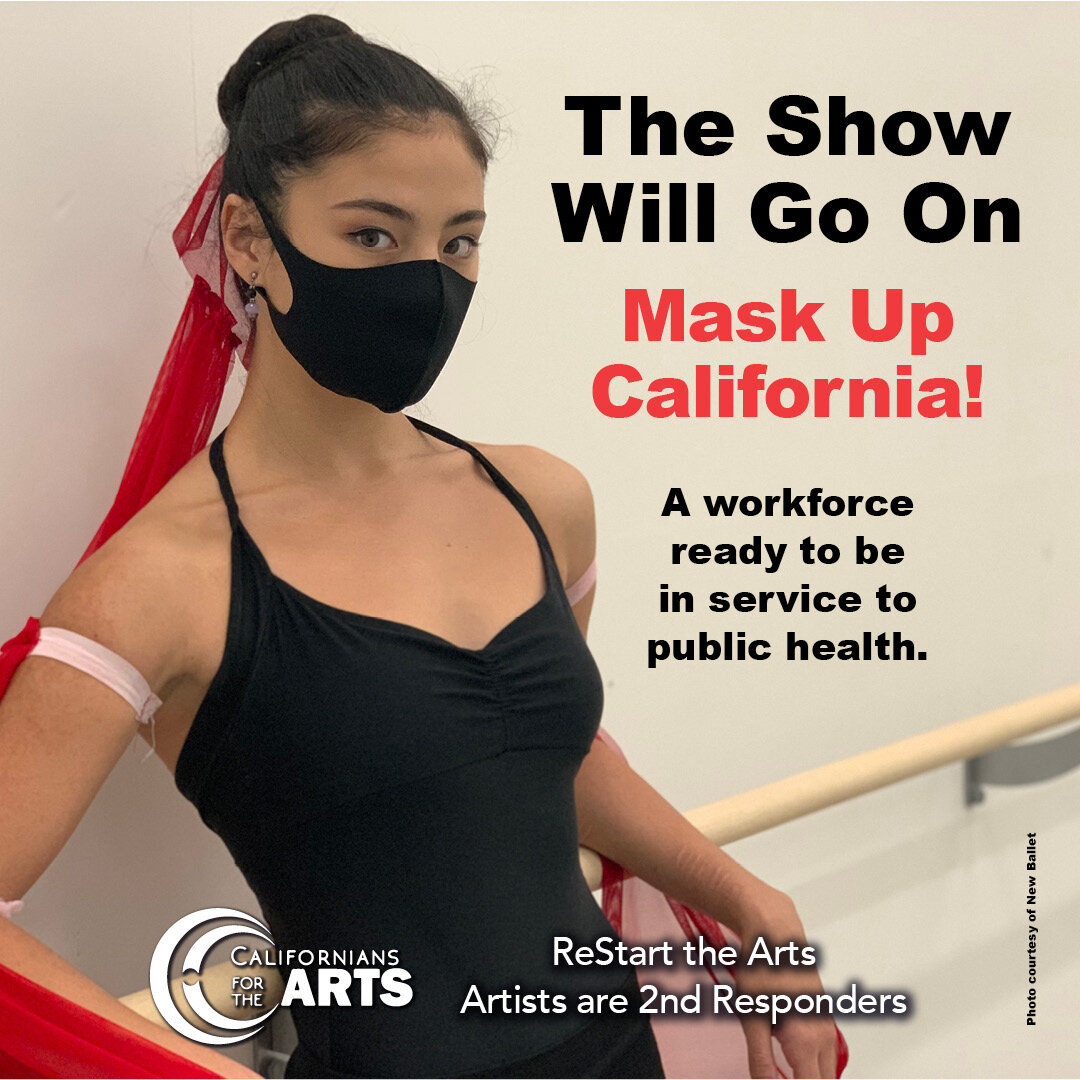


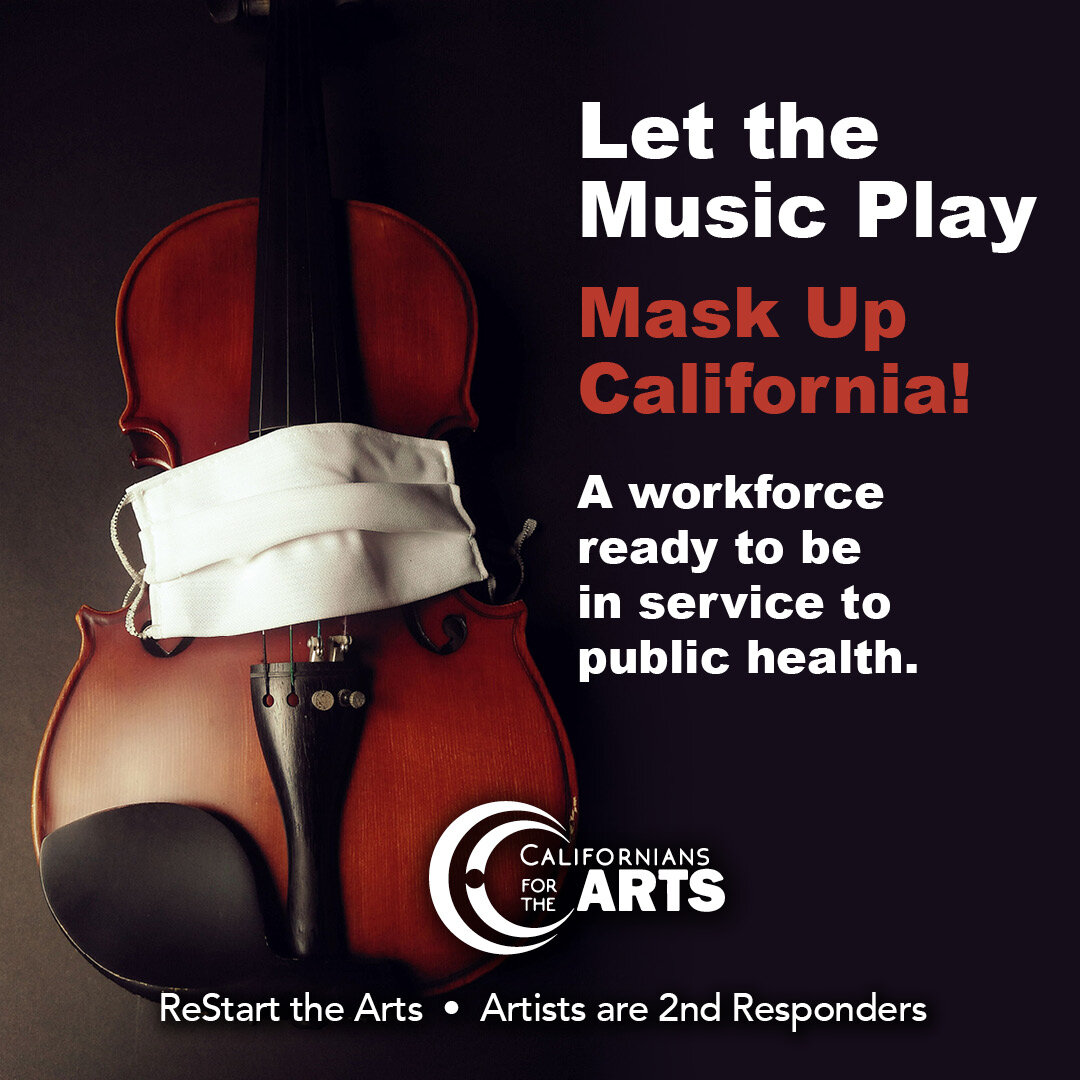

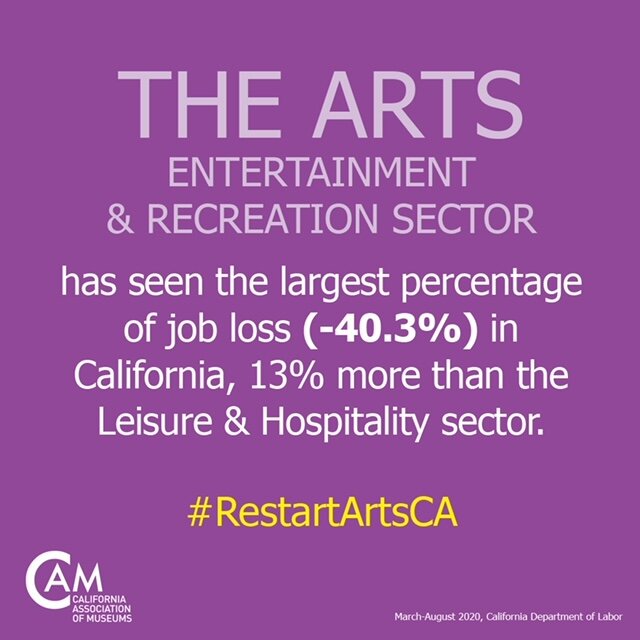
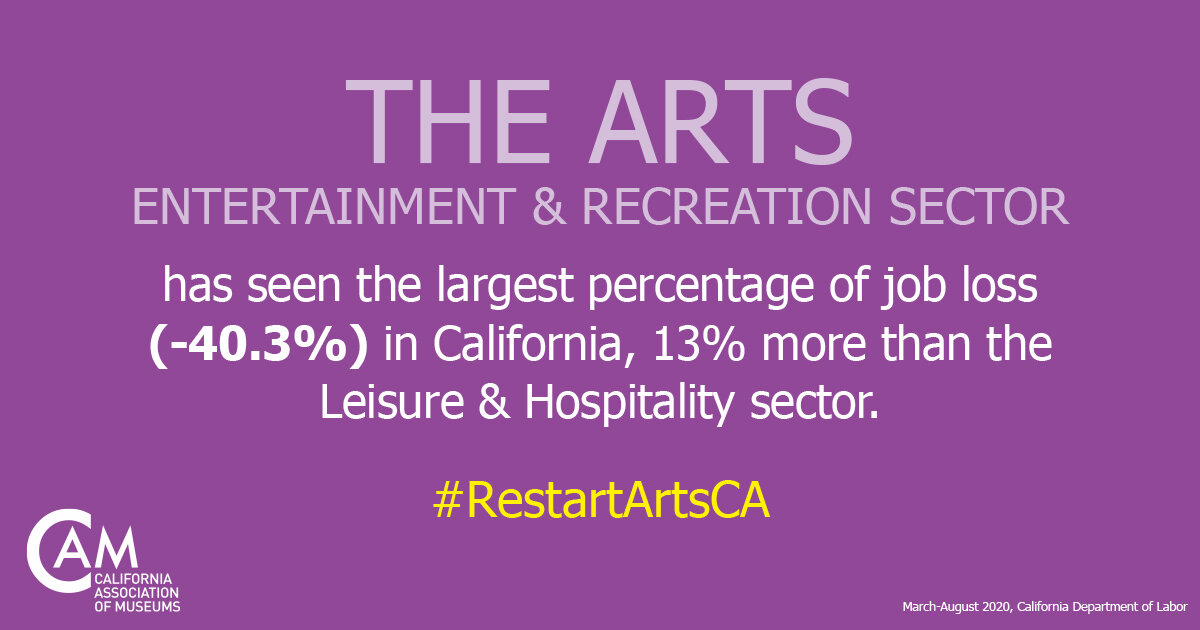







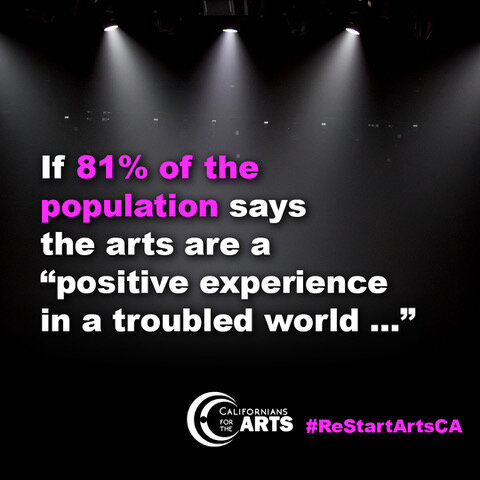
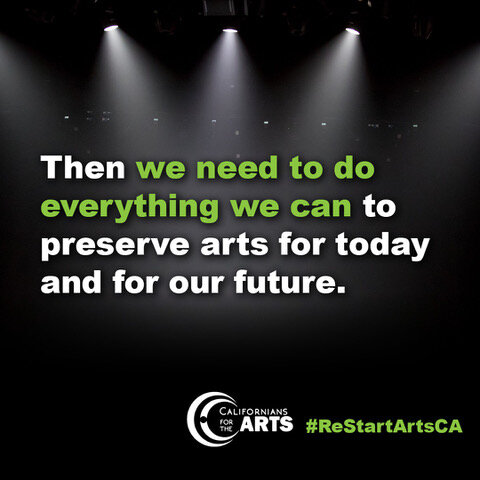
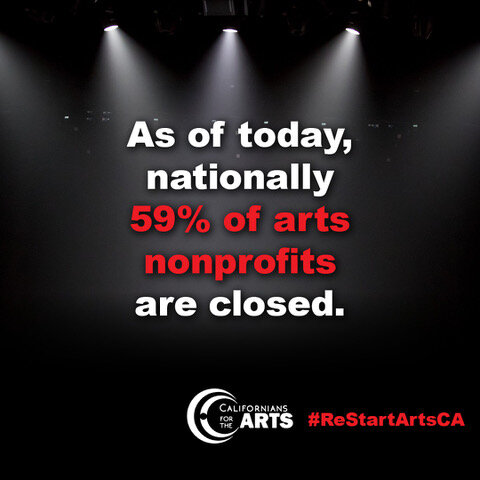
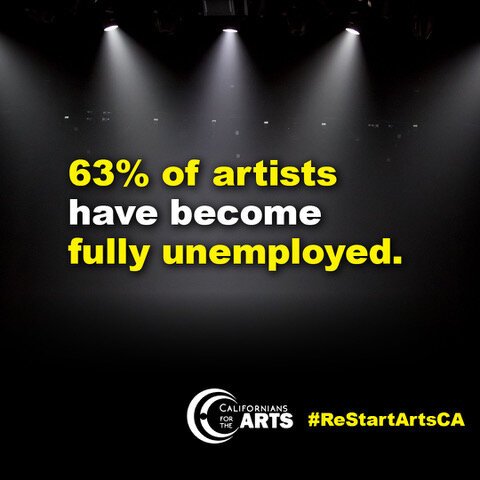

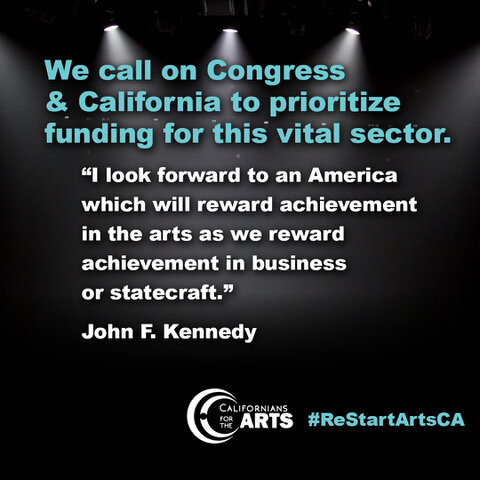

#RestartArtsCA Press
Reopening Arts Safely (RAS) Talking Points
Theaters, arts venues, and museums are professional people movers and managers, experts in logistics and crowd control and have invested over the years, pre-pandemic in detailed safety protocols and are already investing in pandemic safety protocols including upgrading ventilation systems. We know how to keep people safe. Our industry includes labor unions to make sure performers are protected too.
Most of the live events industry has been sidelined by the pandemic. We are not the problem in fact, we can be a part of the solution. We are an underutilized and vital workforce that could support the state in educating people how to coexist with the pandemic including learning new behaviors while still providing an outlet for joy, fun, hope, entertainment and belonging.
People need an outlet right now. Arts can provide mental and emotional health benefits and we can do it safely if consistent guidelines are offered for controlled events and experiences.
We know the arts are not only an economic driver for every community in CA, they also provide the social and emotional wellbeing we so desperately need right now. Producing state guidelines for live performing arts events to happen outdoors and depending on the county tier indoors for streaming or with limited audiences is a critical and urgent need for California.
We know the financial impact the creative economy has provided to our state before this pandemic, so it is vital to preserve and position so it can once again be an economic driver across California.
Hundreds of millions of dollars have been invested in performing arts venues across California. Many of these venues have high quality HVAC systems already installed that we know is critical to preventing the spread of the coronavirus.
We can safely bring people together for a live event or experience in a controlled environment, which is much safer than the family gatherings or backyard community-type events that are happening without guidelines.
Arts organizations are uniquely qualified to work with parks and recreation and libraries to support healthy and safe live events.
With the state’s “health equity metric” and an emphasis on communities most impacted by COVID-19, arts can be a community builder and a public health behavior change model.
With consistent state guidelines, all counties are operating from the same playbook. This is a more equitable practice and safer for everyone.
Many county public health officials are looking to the state for the guidance as they do not have the capacity to create their own county guidelines for the arts.
RAS Talking Points for Museums
Reopening indoor museums in Tier 1, Purple at 25% capacity with the state’s existing guidance will not undermine our shared goal to reduce community spread of COVID-19.
California is the last state to allow museums to reopen in some capacity statewide. Even states that took similar steps to prevent the spread of the coronavirus, such as New York, Oregon, Washington, and Massachusetts, have all allowed museums to reopen with limited capacities.
If museums were to reopen in at 25% capacity in Tier 1—even with no new requirements or conditions—they would still be held to a much higher standard than shopping malls, which have fewer safety control requirements.
Museums typically have high-quality HVAC systems to preserve the art and artifacts in their care, as well as a tradition of being “no touch” and sanitary environments.
What Is the Action We Need From Policymakers
For the State to look at us a resource and events/gathering model to support public health messages, public behavior change and mental health. In order to do that we need state guidelines for live events at every tier.
Parity with other sectors with similar risk profiles, e.g. movie theaters and cultural ceremonies with live performing arts events and museums with shopping malls.
Parity between museums and shopping malls and retail. If necessary, adopt additional modifications in the Purple Tier to allow museums to reopen at 25% capacity.
Reasonable timeline to reopen. We know we can present events safely and it’s hurting our communities’ mental and economic health to go without the arts and culture industry.
Reasonable guidelines that are feasible and practical.
Iterative and collaborative process with public health and our industry experts.
Recognition that one size does not fit all (just as there are different tiers for counties) should be different considerations for different types of live events.
Economic Impact Due to Ongoing Closures From COVID 19 to CA Arts & Creative Industries
CA Arts, Culture and entertainment Industry suffers from one of the highest unemployment rates with one- third of our sector out of work. That is more than 450,000 jobs and an estimated $45B in accumulative economic loss. That’s 30.4% of California’s creative jobs lost due to COVID.(April - July, Brooking’s Institution)
CA Dept of Labor reports from March - August 2020, Arts, Entertainment & Recreation has seen the largest percentage of job loss (-40.3%) in the state—well beyond even the second larger sector’s percentage of job loss: “Leisure & Hospitality” (-27%)
According to the August 2020 CA EDD Information, more than 260,000 UI claims for arts, culture & entertainment statewide since the pandemic began. Prior to the U.S. outbreak, an average of 730 workers in this sector applied for unemployment benefits during the first nine weeks of 2020.
Of the 50 states, California will be hit hardest in terms of absolute losses for creative industries and occupations, followed by New York and Texas. (Brookings)
In a June survey by NIVA, 90 percent of independent venues reported that they would shutter before the end of the calendar year unless Congress passes legislation that will enable them to cover expenses until there is a vaccine and it's safe to host concerts at full capacity.
One-third of museums may shutter forever as funding sources and financial reserves run dry during the global pandemic, according to results from a survey conducted by the American Alliance of Museums in July 2020.
California is home to nearly 2,000 nonprofit orchestras, ensembles, bands, choral groups, operas, music festivals, and concert series (2020 Guidestar data) all of which cancelled all live programming for the rest of their 2019/20 seasons (March-Aug 2020) and most have cancelled the majority or the entirety of their 2020/21 seasons (Sept 2020-Aug 2021).
According to a 2014 League of American Orchestras study, 75% of all earned income for orchestras (which was 40% of total income) in 2014 was generated from performance and performance-related activities. In California, orchestras that are members of ACSO are projecting at least a 50% drop in total revenue for FY21 due to concert and program cancellations.
Arts & Creative Industries Economic Impact to CA (Pre-Covid-19)
U.S. Bureau of Economic Analysis reports that in 2017, the arts and culture sector contributed $230.3 billion to California’s economy, representing 8.2% of the state’s GDP—a larger share of the state’s economy than Construction ($102 billion), or Transportation ($72 billion)
2020 Otis Report on the Creative economy states 15.4% of all jobs (2.7 million, direct, indirect and induced) in California are in the creative industries, generating $650.3 billion in total annual output per year.
According to the 2013 Otis Statewide Creative Economy Report, 1 in 10 jobs in California are part of the creative industries, and the direct, indirect and induced workers paid nearly $13.0 billion in property taxes, personal income and sales taxes into the state general fund and to local governments. (reference)
California museums have a $6.55 billion financial impact on the economy and support over 80,000 jobs. The museum sector generated $492 million in tax revenues for the State of California in 2017, in addition to over $1 billion in federal taxes. For every direct job at a museum, an additional job is supported elsewhere in the economy. This is a higher rate than many other industries.
According to the National Endowment for the Arts: California’s arts and cultural industries employed 764,100 workers. These workers earned wages and benefits totaling over $95.9 billion.
The 11,563 arts nonprofit establishments in California eclipse the number of similar organizations in many of the world’s largest economies. These organizations work to nurture artistic talent, present work, archive and preserve materials and cultural practices, and unite individuals for collaborative creative engagement throughout the State. In 2018, they collectively maintained assets valued at $18.67 billion and brought in $5.03 billion in revenue. (Otis report)
Rural counties with performing arts organizations have 3 times more population growth, attract more workers and jobs, and provide higher incomes. Those with design-driven business recover quicker from recessions. (Rural establishment innovation survey, U.S. Dept. of Agriculture Economic Research Service (2018)
California currently ranks 26th among the states in per capita ongoing general fund support for the arts with .71 cents per capita in spending, according to the National Assembly of State Arts Agencies
Attendance and Support for the Arts
Arts and creativity strengthen economic health by creating jobs in multiple industries, driving tourism, and providing opportunities for young people.
According to NEA: 46.8% of California’s adults attended live music, theater, or dance performances, while 24.8% attended art exhibits.
Seventy-six percent of all U.S. leisure travelers participate in cultural or heritage activities such as visiting museums. These travelers spend 60 percent more on average than other leisure travelers.
72% of Americans attend arts or cultural events, such as the theater, museum, zoo, or a musical performance. Arts attendees spend $31.47 per person, per event, beyond the cost of admission (meals, retail, and lodging)—vital commerce for local businesses.
89% of Americans believe that museums provide important economic impacts back to their communities.
68% of Americans agree that the arts improve health and the healthcare experience—and 73% favor government funding for arts in healthcare programs.
34% of arts attendees live outside the county in which the arts event takes place; they spend an average of $47.57 apiece. 14% of nonlocal attendees had a lodging cost and spent $162 per person.
General Talking Points: Ideas for Op-Ed Subjects
Arts Are Part of the Solution
Artists are 2nd responders helping to rebuild lives and communities during the crisis. Artists respond to civil unrest, mental health and public health crises to provide critical services to communities.
Arts and creativity improve Californians’ health and well-being. Arts programs are one of the most effective treatments for trauma, depression and anxiety, including among our nation’s veterans. Arts and creativity reduce our susceptibility to stress-related diseases. And arts therapies help to forestall Alzheimer’s and promote lifelong brain health, while stemming the tide of the opioid crisis.
Life expectancy increases the more you visit an art venue. A study conducted by the British Medical Journal showed that people who went to a museum or the theater once a month or even every few months had a 31 percent reduced risk of dying. We need arts more than ever before.
Arts and creativity make us stronger—as individuals, families, communities, states and as a country. They are a backbone of innovation, prosperity, and thriving people and places. Public funding for arts and creativity is a high-return investment that benefits every American in every city, town and rural community nationwide.
Our industry is critical for economic development. We provide communities with a quality of life that attracts employers and retains employees.
Without arts and culture, without theaters, museums, symphonies, choruses and operas, or ballet, communities will suffer, employers will leave, and jobs will disappear.
Our industry is an economic driver for restaurants, bars, lodging, parking, and retail. According to the American for the Arts, for every admission ticket an art patron purchases, they will spend on average $31 each out to eat, at a bar, to park or stay overnight.
Arts-education experiences improve school engagement and college aspirations.
Arts organizations provide thousands of free programs to underserved communities.
Rice University’s Kinder Institute for Urban Research found arts-learning experiences benefit students in terms of reductions in disciplinary infractions, increases in compassion for others and improvements in writing achievement.
K-12 students who participated in one art museum field trip demonstrated stronger critical thinking skills, displayed higher levels of tolerance, and had more historical empathy.
The typical museum devotes three-quarters of its education budget to K-12 students.
After their families, Americans rank authentic artifacts in history museums and historic sites most significant in creating a strong connection to the past.
Children who visited a museum during kindergarten had higher achievement scores in reading, mathematics and science in third grade than children who did not. Children who are most at risk for deficits and delays in achievement also see this benefit.
A study in Norway found that an appreciation of culture and the arts can lower the risk of anxiety and depression.
Frequent museum visits increase a person’s well-being to the same degree as making an additional $5,301 per year.
More people visited an art museum, science center, historic house or site, zoo, or aquarium in 2018 than attended a professional sporting event.
Support for museums is robust regardless of political persuasion. 96% of Americans would approve of lawmakers who acted to support museums. The number is consistently high for respondents who consider themselves politically liberal (97%), moderate (95%), or conservative (93%).
COVID-19 Impact on California Arts, Culture, Creative Industries
Arts have been associated with super spreader events when in fact studies are showing that is not true. There is mounting evidence that confirms outdoor and controlled gatherings are safer than initially suspected by public health experts. One recent study conducted in Germany suggests that distanced indoor performances with mask protocols, proper ventilation, and hygiene measures pose a very low risk to the public. Source; NYTIMES
The art and entertainment sectors are a vital part of California’s economy and need to be treated as such with safe and reasonable guidelines for reopening.
No business can be expected to survive without relief aid who have been forced to close to the public for eight plus months, with all indications they will not be able to reopen to full capacity until well into 2021.
Arts workers are real workers, vital economic and social contributors to our communities.
Artists and the individuals who work for arts organizations are real people with real jobs supporting themselves and their families and provide essential services to their community.
Our industry thrives on creativity and innovation. We are being called upon now to advocate not only for our survival but for the survival of arts and culture within California.
Highly trained classical musicians are talking about leaving the arts sector to find jobs in other industries because they cannot wait another year or more to get work again.
This is a business crisis and will soon be a civic and economic development crisis if institutions don’t receive relief funding soon.
Online content is becoming increasingly challenging with licensing rights, delays in approval from social media giants like Facebook and Instagram, limited to no revenue streams, competition for attention over one medium, not to mention the huge paradigm shift for artists and presenters.
The arts also provide shared experiences in public spaces—a community connection that heals the loneliness caused by isolation and social distancing. The coronavirus toll is heavy, but the arts can be our greatest asset in recovering from the crisis socially and economically. Doing everything in our power to bolster the arts now will make our communities and states stronger later.
Recording performances, editing, and all the modifications needed to present quality performances via online stream all require huge amounts of up-front costs, which many live presenting houses and small performing arts organizations cannot mount given the already fragile ecosystem.
Approximately one-third of orchestras in the Assoc. CA Symphony Orchestra’s(ACSO) network have been offering high-caliber virtual programming largely for free. They are doing it to stay connected to and support their communities, to keep their musicians working, and to retain donor engagement, but there is a financial cost to producing it and they cannot do it indefinitely. It will not generate the revenue they need to sustain themselves until normal operations can be resumed. (based on a survey of virtual events by ACSO members in October 2020)
If our industry doesn’t get financial help, this crisis will become an education and human service crisis as our programs and services support and uplift schools, hospitals, health care, elderly care, early childhood development, and the underserved.
Our institutions have made challenging and prudent business decisions to survive. Relief funding for arts and culture is a critical investment.
The vast majority of California’s performance venues depend on donors, grants, and often up to 50% of our revenue comes from ticket sales; donors, foundations, and our audiences are all in their own form of economic crises.
Resources
Advocacy Resources
Reopening Resources



















